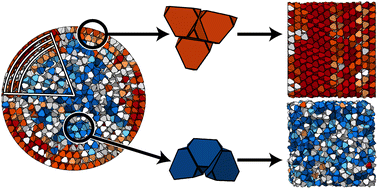Tuning assembly structures of hard shapes in confinement via interface curvature
Abstract
Assembly in confinement is a problem of great interest in colloidal structure design, plasmonics, photonics, and industrial packaging. Along with the range of design choices provided by particle shape and attraction or repulsion, confined systems add an additional layer of complexity through the interactions between particles and the container holding them. The range of possible behaviors produced by these systems remains largely unexplored, yet has profound consequences on the resultant assembled structure. Here, we address this problem by exploring how the assembly of hard tetrahedral particles is affected by a spherical container. We simulate particle assemblies in containers holding 4 to 10 000 particles and analyze the range of resultant structures. We find that the presence of a curved wall causes organization into distinct concentric shells in containers holding up to thousands of particles. In addition, we see that wall curvature affects structural motifs in systems as large as 10 000 particles, promoting local environments that maximally conform to the wall and providing a seed for the propagation of these motifs into the interior of the container. Through this work, we show how confining interfaces can be used to promote the assembly of structures markedly distinct from those seen in the more commonly studied bulk systems.



 Please wait while we load your content...
Please wait while we load your content...